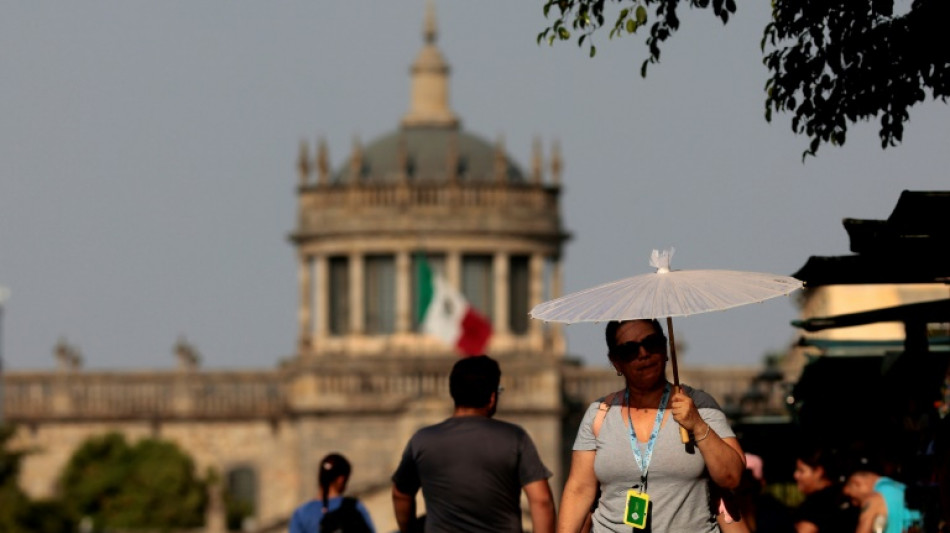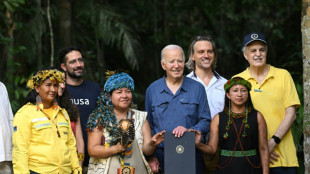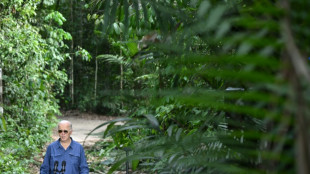
-
 Woman-owned cafe in Indonesia's Sharia stronghold shakes stigma
Woman-owned cafe in Indonesia's Sharia stronghold shakes stigma
-
Indigenous Australian lawmaker who heckled King Charles censured

-
 End of an era as Nadal aims for winning Davis Cup farewell
End of an era as Nadal aims for winning Davis Cup farewell
-
Trump taps big tech critic Carr to lead US communications agency

-
 Mitchell-less Cavs rip Hornets as perfect NBA start hits 15-0
Mitchell-less Cavs rip Hornets as perfect NBA start hits 15-0
-
Markets swing after Wall St losses as traders weigh US rates outlook

-
 India's capital shuts schools because of smog
India's capital shuts schools because of smog
-
Rio under high security for G20 summit

-
 G20 leaders to grapple with climate, taxes, Trump comeback
G20 leaders to grapple with climate, taxes, Trump comeback
-
Hopes set on G20 spurring deadlocked UN climate talks

-
 Gabon early results show voters back new constitution
Gabon early results show voters back new constitution
-
Child abuse police arrest star Australian broadcaster

-
 Disgraced Singapore oil tycoon to be sentenced for fraud
Disgraced Singapore oil tycoon to be sentenced for fraud
-
Stray dogs in Giza become tourist draw after 'pyramid puppy' sensation

-
 UN Security Council to weigh call for immediate Sudan ceasefire
UN Security Council to weigh call for immediate Sudan ceasefire
-
Is AI's meteoric rise beginning to slow?

-
 Israeli strikes on Beirut kill six, including Hezbollah official
Israeli strikes on Beirut kill six, including Hezbollah official
-
Rain wipes out England's final T20 in West Indies

-
 US speaker opposes calls to release ethics report on Trump's AG pick
US speaker opposes calls to release ethics report on Trump's AG pick
-
McDonald's feast undercuts Trump health pledge

-
 Thousands march through Athens to mark student uprising
Thousands march through Athens to mark student uprising
-
NBA fines Hornets' Ball, T-Wolves' Edwards, Bucks coach Rivers

-
 China's Xi says to 'enhance' ties with Brazil as arrives for G20: state media
China's Xi says to 'enhance' ties with Brazil as arrives for G20: state media
-
Bills snap nine-game Chiefs win streak to spoil perfect NFL start

-
 Biden answers missile pleas from Ukraine as clock ticks down
Biden answers missile pleas from Ukraine as clock ticks down
-
Senegal ruling party claims 'large victory' in elections

-
 Dutch plan 'nice adios' for Nadal at Davis Cup retirement party
Dutch plan 'nice adios' for Nadal at Davis Cup retirement party
-
Trump meets PGA boss and Saudi PIF head amid deal talks: report

-
 UN chief urges G20 'leadership' on stalled climate talks
UN chief urges G20 'leadership' on stalled climate talks
-
Steelers edge Ravens, Lions maul Jaguars

-
 No.1 Korda wins LPGA Annika for seventh title of the season
No.1 Korda wins LPGA Annika for seventh title of the season
-
Biden touts climate legacy in landmark Amazon visit

-
 England secure Nations League promotion, France beat Italy
England secure Nations League promotion, France beat Italy
-
Star power fails to perk up France's premiere wine auction

-
 Rabiot brace fires France past Italy and top of Nations League group
Rabiot brace fires France past Italy and top of Nations League group
-
Carsley relieved to sign off with Nations League promotion for England

-
 Sinner says room to improve in 2025 after home ATP Finals triumph
Sinner says room to improve in 2025 after home ATP Finals triumph
-
Senegal counts votes as new leaders eye parliamentary win

-
 Biden clears Ukraine for long-range missile strikes inside Russia
Biden clears Ukraine for long-range missile strikes inside Russia
-
Lebanon says second Israeli strike on central Beirut kills two

-
 Puerto Rico's Campos wins first PGA title at Bermuda
Puerto Rico's Campos wins first PGA title at Bermuda
-
Harwood-Bellis risks wedding wrath from Keane after England goal

-
 'Nobody can reverse' US progress on clean energy: Biden
'Nobody can reverse' US progress on clean energy: Biden
-
NBA issues fines to Hornets guard Ball, T-Wolves guard Anthony

-
 Biden allows Ukraine to strike Russia with long-range missiles: US official
Biden allows Ukraine to strike Russia with long-range missiles: US official
-
Britain dump out holders Canada to reach BJK Cup semi-finals

-
 Biden clears Ukraine for missile strikes inside Russia
Biden clears Ukraine for missile strikes inside Russia
-
Ukrainians brave arduous journeys to Russian-occupied homeland

-
 Australia not focusing on Grand Slam sweep after thrashing Wales
Australia not focusing on Grand Slam sweep after thrashing Wales
-
Wales's rugby woes -- three talking points


Climate change made deadly heat 35x more likely in US, Mexico, C. America
Deadly heat that blanketed the United States, Mexico and Central America recently was made 35 times more likely due to global warming, an international network of climate scientists said on Thursday.
The World Weather Attribution (WWA) group of scientists also said that extreme highs witnessed over that region in May and June were four times as likely to occur today as a quarter of a century ago.
The record-breaking heat killed at least 125 people in Mexico and caused thousands more to suffer heat strokes, a potentially fatal condition that occurs when the body's internal cooling mechanisms start to fail.
"We likely do not know the full picture of heat-related deaths, since they are usually only confirmed and reported months after the event, if at all," said WWA, which uses peer-reviewed methods to assess links between specific extreme events and global warming.
They said that as the world continues to burn fossil fuels and emit climate-heating greenhouse gases into the atmosphere, millions more people are expected to be exposed to dangerous levels of heat in the future.
This year has been the hottest on record and already large swathes of the world have endured blistering temperatures before the onset of the northern hemisphere summer.
Greece has notched its earliest-ever heatwave, India has suffered a month-long stretch of searing highs, while the United States is dealing with wildfires and scorching conditions.
And in Saudi Arabia, at least 900 people died during the annual hajj pilgrimage, mostly from unforgiving heat with temperatures in Mecca hitting 51.8 degrees Celsius (125 degrees Fahrenheit) on Monday.
- 'Between life and death' -
For its study, WWA analysed the hottest five consecutive days and nights during a "heat dome" that lingered over the southwest United States, Mexico, Guatemala, Belize, El Salvador and Honduras in late May and early June.
The scientists have pioneered ways to use climate models to understand how these types of extreme events have changed in a world that is 1.2 degrees Celsius warmer than in pre-industrial times.
They concluded "that human-induced warming from burning fossil fuels made the five-day maximum temperature event about 1.4 degrees hotter and about 35 times more likely".
WWA warned that if humans continue burning fossil fuels in the near term, these extremes could become more frequent still.
"The additional 1.4C of heat caused by climate change would have been the difference between life and death for many people during May and June," said Karina Izquierdo, urban advisor for the Latin American and Caribbean region at Red Cross Climate Centre.
"As well as reducing emissions, governments and cities need to take steps to become more resilient to heat," she said in a statement.
Heat is the deadliest of all extreme weather but often underestimated, experts say, with children, the elderly and outdoor workers particularly vulnerable.
In Mexico and Central America, the impacts of heat are intensified by poor housing conditions, limited access to cooling services, and for those living in informal settlements.
Extreme heat also threatens the stability of electricity supply, which is critical to the functioning of healthcare facilities.
Scientists said that extreme heat warming systems and action plans could help bolster Central America's preparedness for such events, with safety measures needed to protect outdoor workers.
Green spaces and improved infrastructure in informal settlements would also help protect the most vulnerable people, WWA added.
T.Wright--AT


